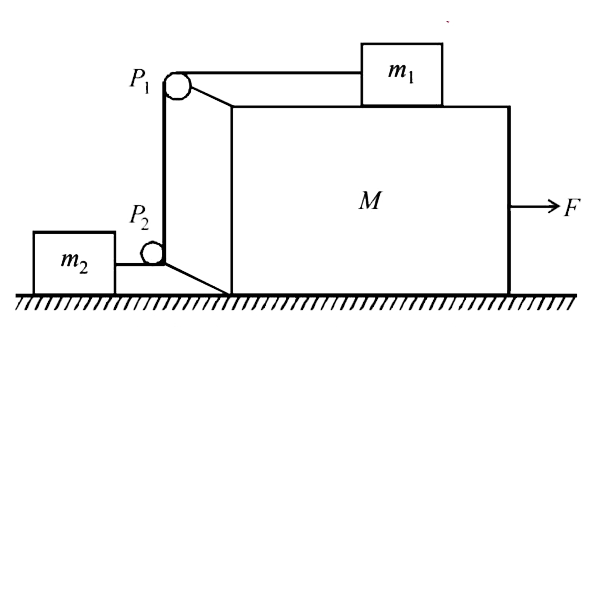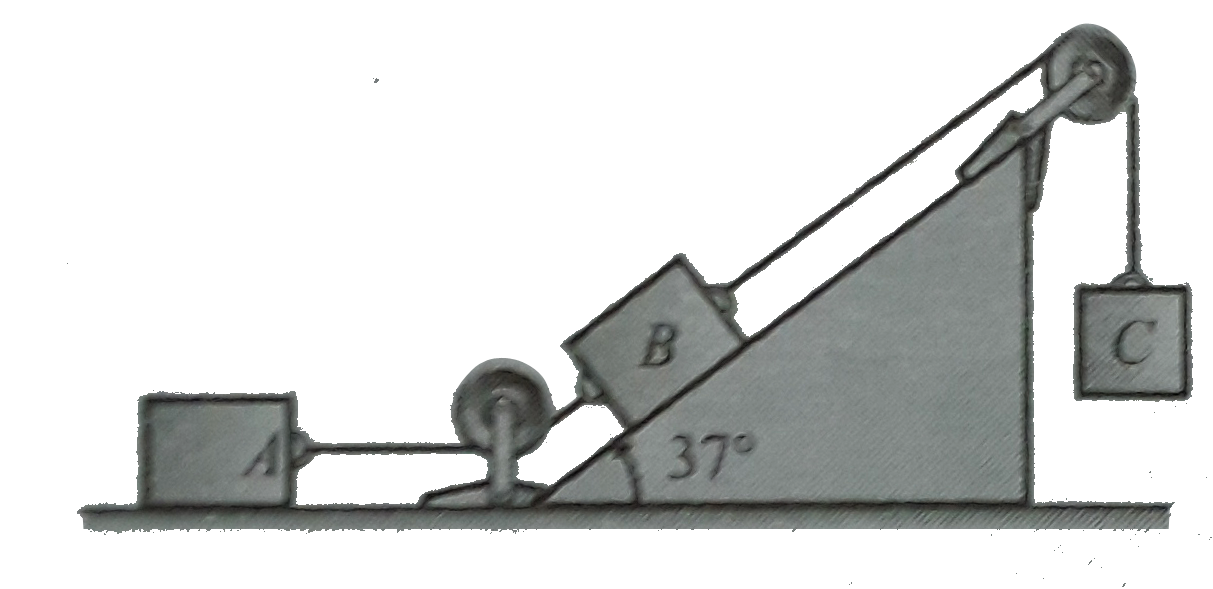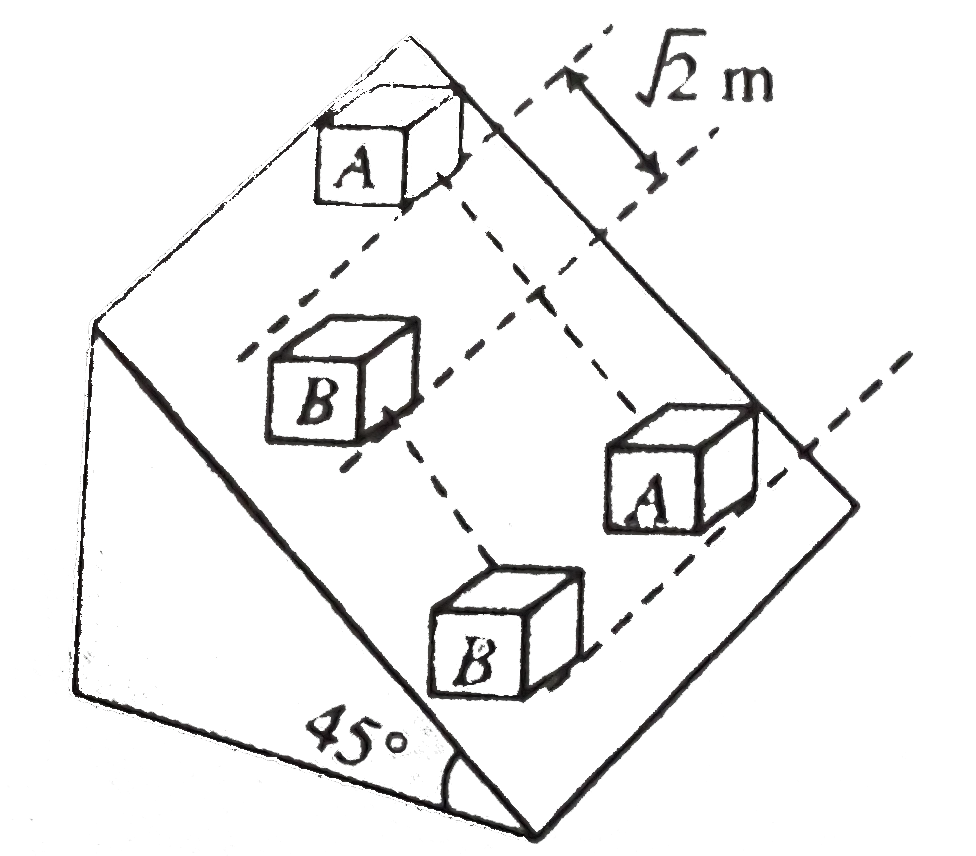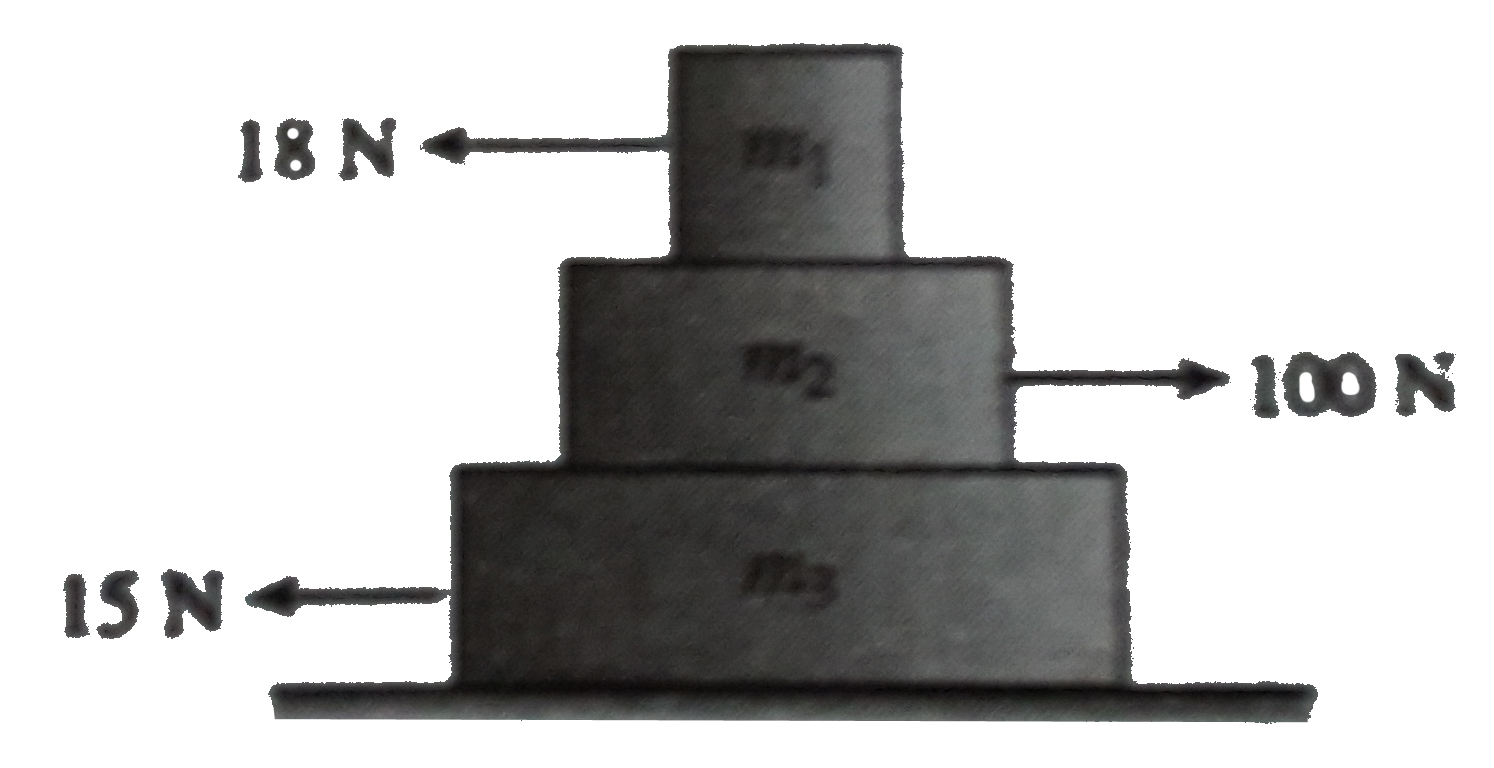Complete Solutions to Solved Examples of chapter NEWTON'S LAWS OF MOTION 2 of Class 11 book with complete answers and questions
| Class 11 | PHYSICS |
| Chapter | NEWTON'S LAWS OF MOTION 2 |
| CENGAGE PHYSICS | Solved Examples |
| Number Of Questions | 12 |
| Academic Year | 2023-24 |
In the figure masses `m_1`, `m_2` and M are 20 kg, 5kg and 50kg respectively. The coefficient of friction between M and ground is zero. The coefficient of friction between `m_1` and M and that between `m_2` and ground is 0.3. The pulleys and the strings are massless. The string is perfectly horizontal between `P_1` and `m_1` and also between `P_2` and `m_2`. The string is perfectly vertical between `P_1` and `P_2`. An external horizontal force F is applied to the mass M. Take `g=10m//s^2`.

(a) Draw a free body diagram for mass M, clearly showing all the forces.
(b) Let the magnitude of the force of friction between `m_1` and M be `f_1` and that between `m_2` and ground be `f_2`. For a particular F it is found that `f_1=2f_2`. Find `f_1` and `f_2`. Write equations of motion of all the masses. Find F, tension in the spring and acceleration of masses.18:44View SolutionBlocks `A, B and C` are placed as shown in Fig and connected by the rops of negligible mass . Both `A` and `B` weigh `25.0 N ` each , and the coefficient of kinetic friction between each and the surface is `0.35` blocks `C` descends with constant velocity .

a. Draw two separate free- body diagrams showing the forces acting on `A and B`
b. Find the tension in the rope connecting blocks `A and B`
c. What is the weight of blocks C?
d. If the rope connecting `A and B` were cut, what would be the acceleration of C?09:49View SolutionTwo blocks `A` and `B` of equal masses are placed on rough inclined plane as shown in Fig. When and where will the two blocks come on the same line on the inclined plane if they are released simultaneously ? Initilly the blocks `A` is `sqrt(2) m` behind the block `B` .Coefficient of kinetic friction for the block `A` and `B` are `0.2` and `0.3` respectively `(g = 10 ms^(-2))`
 03:17View Solution
03:17View SolutionFind the acceleration `a_(1) , a_(2) and a_(3)` of the three blocks shown in Fig if a horizontal force of `10 N` is applied on

(a) `2 kg` blocks, (b) `3 kg` blocks and ( c) `7 kg` blocks (Take `g = 10 ms^(-2))`10:28View SolutionIn the sitution shown in figure there is no friction between `2 kg` and ground.

a. For what maximum value of force `F` can all three blocks move together?
b. Find the value of force `F` at which sliding starts at other rough surfaces.
c. Find acceleration of all blocks, nature and value of friction force for the following values of force `F` (i) `10N` (ii) `N` and (iii) `25 N`06:03View SolutionConsider three blocks placed one over the other as shown in Fig. Let as now pull the blocks with the force of magnitudes `18 N, 100 N` and `15 N` Take `m_(1) = m_(2) = m_(3) = 10 kg` If the coefficient of static and kinetic friction between all contacting surface are `mu_(g) = 0.2` respectively find the

(a) Acceleration of the block s
(b) Friction at each surface06:20View SolutionA track consists of two circular pars ABC andCDE of equal rdius 100 m and joined smoothly as shown in figure.Each part sutends a right ngle at its centre. A cycle weighing 100 kg together with rider travels at a constant speed of 18 km/h on the track. A. Findteh nromal contct force by tehroad on the cycle whenit is at B and at D. b.Findteh force of friction exerted by the track on the tyres when the cycle is at B,C and D. c. Find the normal force between teh road and teh cycle just before and just after the cycle crosses C. d. What should be the minimum friction coefficient between the road and the tyre, which will ensure that teh cyclist can move with constant speed? Take `g=10 m/s^2`
 10:25View Solution
10:25View SolutionTwo blocks `A(m_(A) = 5 kg)` and `B(m_(B)= 15 kg)` are placed as shown in Fig A variable force `F = 200` starts actsing from time `t = 0` on lower bolck B just large anough to Determine the force `F` to make block B sliding out from between the blocks A and the ground at this instant , plot a graph between acceleration of both the blocks and time
 08:43View Solution
08:43View SolutionA block of mass `m_(1) = 20 kg` as placed on a wedge of mass `m_(2)= 30 kg` rest on a smooth flooras shpwn in Fig (a) . Friction exists between block and wedge.
a. Find the acceleration of each block if (i) `F = 180 N` and (ii) `F = 400 N`
b. Solve the problem if force `F = 180 N` is direction upwards as shown in Fig (b)
 05:22View Solution
05:22View SolutionConsider the situation shown in Fig. The hirizontal surface below the bigger block is smooth the coefficient of friction between the block is `mu` find the minimum and the maximum force `F` that can be applied in order to keep the smaller blocks at rest with respoct to the bigger block
 07:01View Solution
07:01View SolutionA metal ring of mass m and radius R is placed on a smooth horizontal table and is set rotating about its own axis in such a way that each part of the ring moves with a speed v. Find the tension in the ring.
04:08View SolutionA thin uniform copper rod of length l and mass m rotates uniformly with an angular velocity `omega` in a horizontal plane about a vertical axis passing through one of its ends. Determine the tension in the rod as a function of the distance r from the rotation axis. Find the elongation of the rod.
05:11View Solution
Solved Examples questions and complete solutions for chapter NEWTON'S LAWS OF MOTION 2 of CENGAGE PHYSICS (HINGLISH) of Class 11
